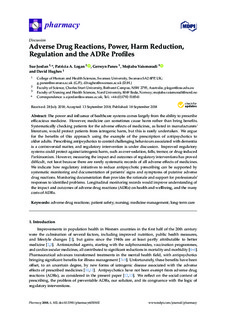| dc.contributor.author | Jordan, Sue | |
| dc.contributor.author | Logan, Patricia A. | |
| dc.contributor.author | Panes, Gerwyn | |
| dc.contributor.author | Vaismoradi, Mojtaba | |
| dc.contributor.author | Hughes, David | |
| dc.date.accessioned | 2018-11-21T14:28:25Z | |
| dc.date.available | 2018-11-21T14:28:25Z | |
| dc.date.created | 2018-09-18T14:21:31Z | |
| dc.date.issued | 2018 | |
| dc.identifier.citation | Jordan, S., Logan, P. A., Panes, G., Vaismoradi, M. & Hughes, D. (2018). Adverse drug reactions, power, harm reduction, regulation and the ADRe profiles. Pharmacy, 6(3): 102. doi: | nb_NO |
| dc.identifier.issn | 2226-4787 | |
| dc.identifier.uri | http://hdl.handle.net/11250/2574174 | |
| dc.description.abstract | The power and influence of healthcare systems comes largely from the ability to prescribe efficacious medicine. However, medicine can sometimes cause harm rather than bring benefits. Systematically checking patients for the adverse effects of medicines, as listed in manufacturers’ literature, would protect patients from iatrogenic harm, but this is rarely undertaken. We argue for the benefits of this approach using the example of the prescription of antipsychotics to older adults. Prescribing antipsychotics to control challenging behaviours associated with dementia is a controversial matter, and regulatory intervention is under discussion. Improved regulatory systems could protect against iatrogenic harm, such as over-sedation, falls, tremor, or drug-induced Parkinsonism. However, measuring the impact and outcomes of regulatory interventions has proved difficult, not least because there are rarely systematic records of all adverse effects of medicines. We indicate how regulatory initiatives to reduce antipsychotic prescribing can be supported by systematic monitoring and documentation of patients’ signs and symptoms of putative adverse drug reactions. Monitoring documentation then provides the rationale and support for professionals’ responses to identified problems. Longitudinal monitoring records would improve understanding of the impact and outcomes of adverse drug reactions (ADRs) on health and wellbeing, and the many costs of ADRs. | nb_NO |
| dc.language.iso | eng | nb_NO |
| dc.publisher | MDPI | nb_NO |
| dc.rights | Navngivelse 4.0 Internasjonal | * |
| dc.rights.uri | http://creativecommons.org/licenses/by/4.0/deed.no | * |
| dc.title | Adverse Drug Reactions, Power, Harm Reduction, Regulation and the ADRe Profiles | nb_NO |
| dc.type | Journal article | nb_NO |
| dc.type | Peer reviewed | nb_NO |
| dc.description.version | publishedVersion | nb_NO |
| dc.rights.holder | © 2018, The Author(s) | nb_NO |
| dc.subject.nsi | VDP::Medisinske Fag: 700 | nb_NO |
| dc.source.pagenumber | 19 | nb_NO |
| dc.source.volume | 6 | nb_NO |
| dc.source.journal | Pharmacy | nb_NO |
| dc.source.issue | 3 | |
| dc.identifier.doi | 10.3390/pharmacy6030102 | |
| dc.identifier.cristin | 1610639 | |

